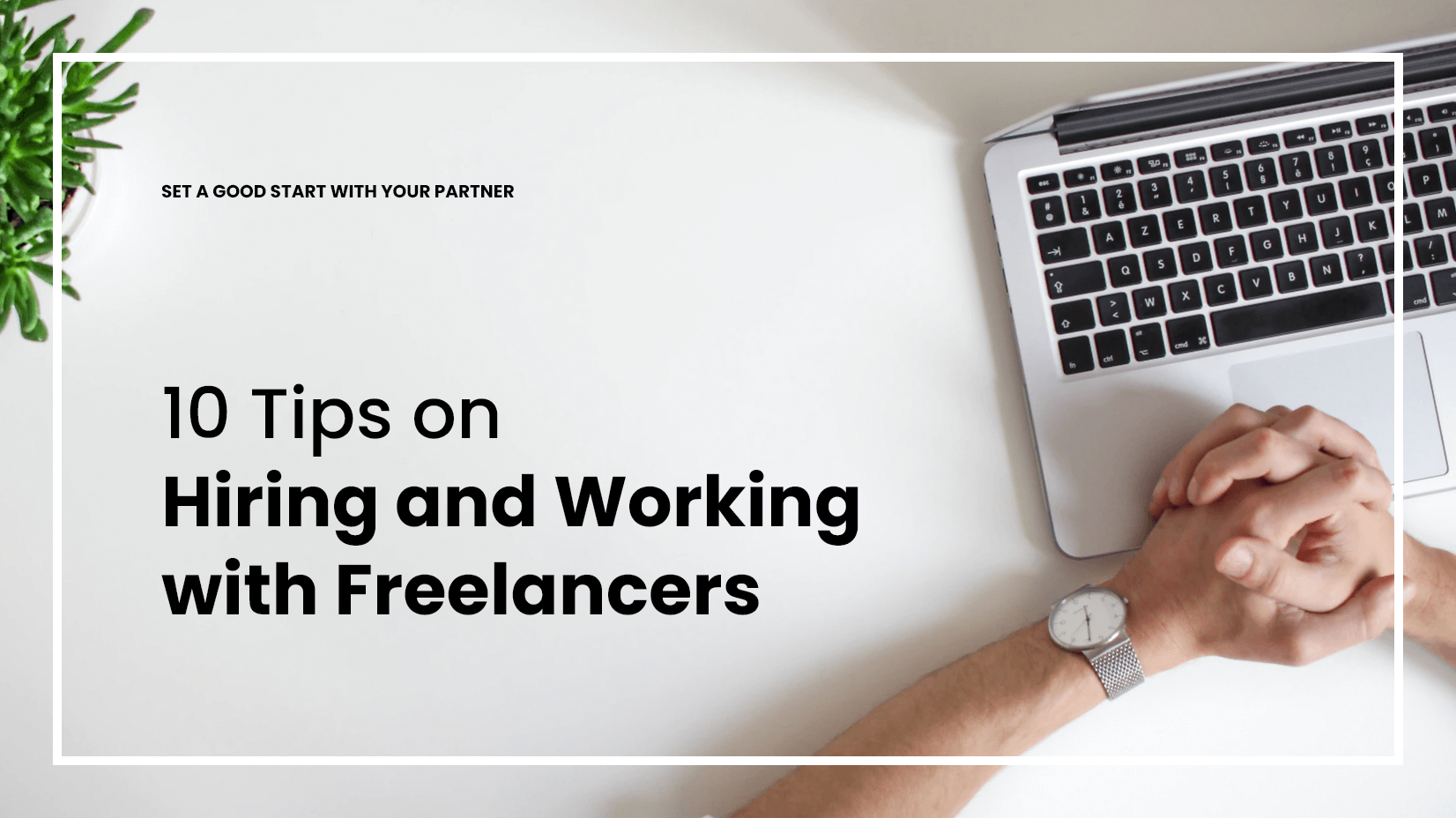
Working with freelancers is not always a flawless experience. In fact, it may turn into quite a challenge, especially if it is new to you. A smooth working process with a freelancer starts way before the actual first contact with them. In this article, we’ve included 10 tips on hiring and working with freelancers that will help you set a good start with your new partner, and will ensure you a seamless experience that leads to the desired results. Let’s begin!
Tip 1: Determine your exact needs
Tip 2: Compare platforms’ terms and conditions
Tip 3: Write a job description that attracts the right candidates
Tip 4: Screen freelancers wisely
Tip 5: Test out the candidate with a small task first
Tip 6: Discuss any legal issues beforehand
Tip 7: Be exquisitely clear in your communication
Tip 8: Understand that the freelancer is not your employee rather than your partner
Tip 9: Be strict with payments
Tip 10: Take time to give feedback and write a testimonial
Tip 1: Determine your exact needs
Both in terms of project requirements and freelancer qualifications.
Before trying to contact a freelancer at all, you must have a clear vision of the scope of work that should be completed, as well as the minimum qualification of the person you will be hiring. Sit down and consider exactly what the scope of your project is, determine timeframes and deadlines, the deliverables you will need, the budget you can set aside.
In terms of freelancer qualifications, make sure to consider major important factors beforehand. This will help you sort out applicants later. Build a profile of the candidate that will be the best fit for your project:
- what background and experience should this person have,
- what specializations are essential for this work,
- how often and for how long you will need their availability,
- and of course – to what extent you can be flexible with the price given by the freelancer himself/herself.
Tip 2: Compare platforms’ terms and conditions
And pay special attention to the taxes and fees of each.
Websites for hiring freelancers work in similar ways but still, their services may differ, as well as the fees (obvious and hidden) they charge. After you’ve identified your requirements and needs, it will be quite easier for you to identify the platform that resonates with you. For example, if you have a low budget, then you will probably go with Fiverr. If you need a highly qualified candidate, you will probably prefer Toptal, etc. Moreover, there are specialized platforms for hiring freelancers in a specific field: design, marketing, web development, etc.
We’ve made a thorough research on freelancer platforms, and more specifically platforms where you can hire freelance designers, so feel free to have a look. Pros and cons are included for each.
Most platforms for hiring freelancers work in two directions. They have a job board where you can publish your job offer and wait for candidates to submit their applications. Or you can browse freelancers by previously applied filters and contact potential candidates directly with your job offering. For example, if you need to have regular face-to-face meetings with your freelancer, you will probably need a platform that provides a location-based filter.
Tip 3: Write a job description that attracts the right candidates
And make sure to include all essential points.
Whether it’s a short or long-term commitment, it’s always more convenient to publish your offer and wait for candidates to apply than browse freelancers and contact them separately to see if you are a match. Not all platforms have this service but luckily most do. This is where platforms’ fees and taxes usually differ but let’s take it that you’ve already done your research and chosen which platform’s terms correspond to your needs best.
Publishing a job offer is your first sifter for candidates which will save you tons of wasted dialogues later, so make sure that it is effective. In general, you know that a job offer should summarize the needs of your project. But an effective job offer includes several major factors whose purpose is to draw the attention of the right freelancers.
- a clear and descriptive title – make it catchy but extremely clear and relevant because freelancers are sifting through offers the same way you are sifting through candidates;
- the scope of work – simply describe exactly what you will be expecting from the candidate;
- freelancer availability – be absolutely explicit of how much availability and commitment you will need from the potential candidate, including live meetings and geographical restrictions;
- turnarounds – describe whether it is going to be short-term or long-term, is there any time constraints, etc.;
- required candidate skills – include the minimum requirements in terms of experience, skills, education, etc;
- and of course, point out the expected budget range and fees.
Tip 4: Screen freelancers wisely
Price is not your only factor!
Whether you are relying on candidate applications or you are browsing freelancers yourself, there are factors that are more important than pricing. If you choose a freelancer that will do the job for less money, you will still have to pay them even if the work is not exactly what you’ve imagined. And then, you’ll have to look for another person to make corrections or even start from scratch. Here are the factors you should look for before considering the pricing:
Experience and previous work. The portfolio of your potential partner is the first thing to look at, especially when it comes to assigning a creative job. To raise the chances of a smoother and more effective working process later, look for similarities in your taste/style and the freelancer’s. This will ensure that both of you will be on the same page when it comes to working on your project. In addition, look for candidates that are specialized in the specific field you need. For example, if you need illustrations for children’s books, prioritize candidates that are specialized in this type of art rather than candidates that show a more diverse portfolio such as illustrations plus web design and coding.
Other clients’ reviews and scores/ratings. No matter how much you love the style of work that the freelancer demonstrates in their profiles, if they get bad reviews, you should probably pass on this application. Reviews from previous clients usually give valuable information beyond the experience of the candidate. Read them to learn if the designer is easy to work with if the communication has been fluent, if they’ve been accurate with schedules and deadlines, etc.
Do a background check beyond their profile on the platform. Often, looking into the social networks and other platforms where the potential candidate has a profile, gives a broader idea of their expertise and personality. This is quite useful, especially if you are going to work with this person for a long period of time. We recommend that you do this after you’ve made your first sifting through candidates.
Tip 5: Test out the candidate with a small task first
To see if they are really the right person for the job.
When working with new freelancers, you never know if you two will really be a match, even if all the research you’ve made shows an optimistic prognosis. The best strategy to go with is to assign a small test project before diving into the deep. A test project will allow you to understand if the communication between you two will be efficient, how many revisions (if any) will be necessary in order to achieve the desired effect, how the freelancer handles deadlines and more.
It will both do you good if you are completely honest from the very beginning. If you don’t like something, let them know and see if they are willing to improve it. If nothing changes, you should probably save each other time and look for another partner for the job.
Tip 6: Discuss any legal issues beforehand
Especially the ownership of the work
This matter should be negotiated upfront. Usually, you would want all ownership rights transferred to you. To make sure you are legally safe and protected, a good practice is to have the freelancer sign a legal document, an agreement, that states that full ownership rights of all completed work belong to you. A fair practice would be to pay a portion of the negotiated price upfront, so the freelancer is also protected from fraud.
If you are working with a freelancer for a third-party client, it is a good idea to have the freelancer sign a non-competition agreement that will protect your assets. By signing such an agreement, the freelancer agrees that they will not cut you out, nor accept similar work from the same client for, let’s say six months or another specified period of time.
Tip 7: Be exquisitely clear in your communication
To make sure you get your project off to a good start.
So far, so good. The test project has been a success and now you are ready to proceed with the actual work. How to make sure everything goes smoothly? Be crystal clear from the very beginning in terms of scope of work, deliverables, turnarounds, and even the possibility that your needs may change over the course of the project.
Let the freelancer know exactly what results you are expecting and when. When working with freelancers, it always helps to provide examples of what you need, as well as all kinds of assets that will ease and speed up their work. Providing examples also helps clear out misunderstandings and avoid too many revisions later on. If necessary, arrange a face-to-face or a video call meeting in order to make sure you’re on the same page with them.
If there is even a slight possibility that the project may evolve and require additional work, make sure to inform the freelancer beforehand. Be prepared that any additional and not previously negotiated work will be charged extra. Negotiate fares with your freelancer when signing off the contract and before starting the actual work.
Tip 8: Understand that the freelancer is not your employee rather than your partner
And they are not solely dedicated to you.
Like it or not, freelancers often take up various projects at the same time. Unless you’ve previously agreed on an exclusive commitment, it’s very likely that the freelancer will not always be accessible because they have an approaching deadline with another client or for another reason. As long as they stick to your agreement and the deadlines you’ve set, you cannot expect them to be at your disposal immediately when you need them.
When working with freelancers, always remember that they are your partners and you should treat them as such. Value their opinion, ask them questions, and encourage them to ask questions, as well when there is something unclear. Moreover, allow them and even encourage them to give ideas. After all, if you’ve followed our guidelines, you must have chosen an expert in the field, so they will definitely know a lot about how to proceed with projects like yours.
Tip 9: Be strict with payments
Compensate freelancers well and on time.
To avoid unnecessary tension between the freelancer and you, make sure to be precise and regular with payments. If you’ve done everything right, both of you must be crystal clear from the very beginning of how and when payments should be happening. Being correct with your freelancer will ensure you a strong and effective partnership not only for this project but for future work, as well. Moreover, it will encourage the freelancer to keep delivering fantastic work.
We’ve already mentioned that you should be prepared for additional payments in case the project evolves or changes its course. It’s always best to have discussed such a possibility beforehand but even if you haven’t, don’t wait for the freelancer to raise the question. Be the first to ask of how much they would want to be compensated for the additional work.
Tip 10: Take time to give feedback and write a testimonial
So you can help them grow.
Giving constant, timely, and understandable feedback is necessary from the very beginning to the completion of your project. It helps you keep the work going smoothly and ensures that the results will be successful as you’ve planned them. Take the time to be detailed and even if you have to be critical, make sure to write your comment in a friendly and professional manner, so both of you can take benefit from it and keep on with the good work.
After project completion, make sure to leave a testimonial for your freelancer on their profile. Your experience with this person may really help their future clients the same way it helped you when you had to choose a freelancer.
Final words
Working with freelancers may not be the easiest job in the world. Sometimes it’s quite challenging, sometimes you will have to cancel your order and start over to find a new, more suitable person for the job. We really hope our guidelines will help you down this road you’ve chosen.
If you, yourself have experience working with freelancers, we’d love to read about your experience in the comments below. Meanwhile, why don’t you check out other articles related to this subject?










